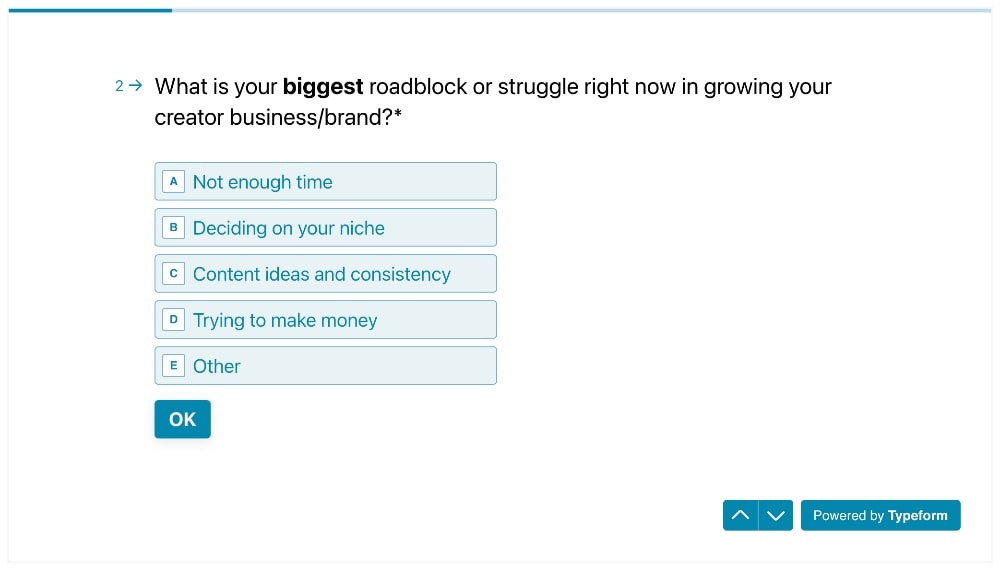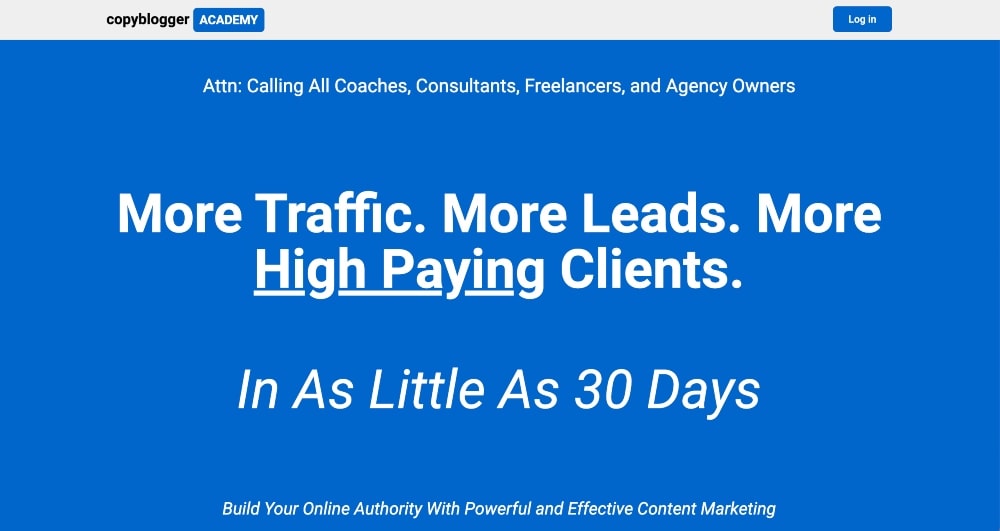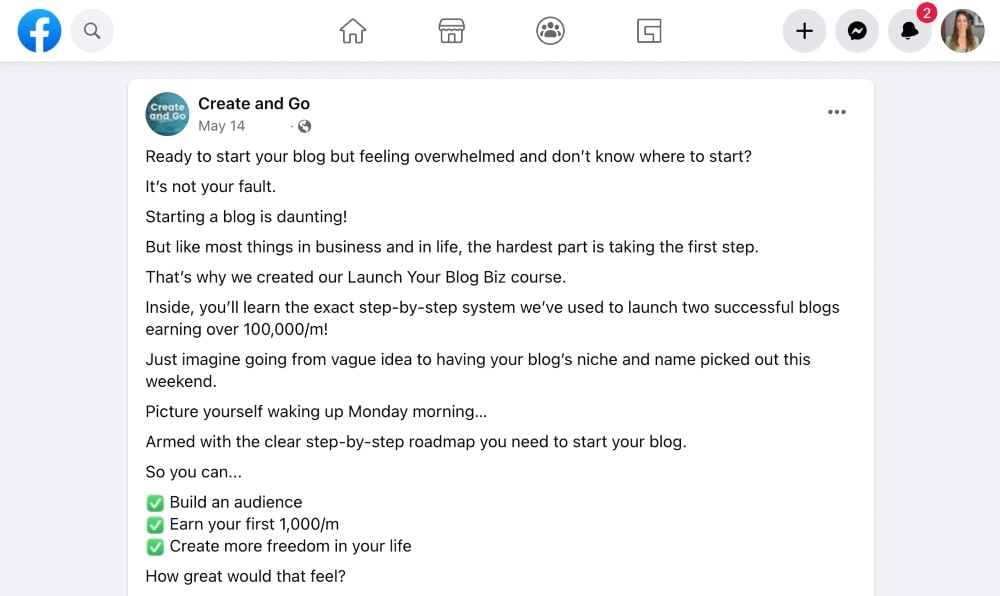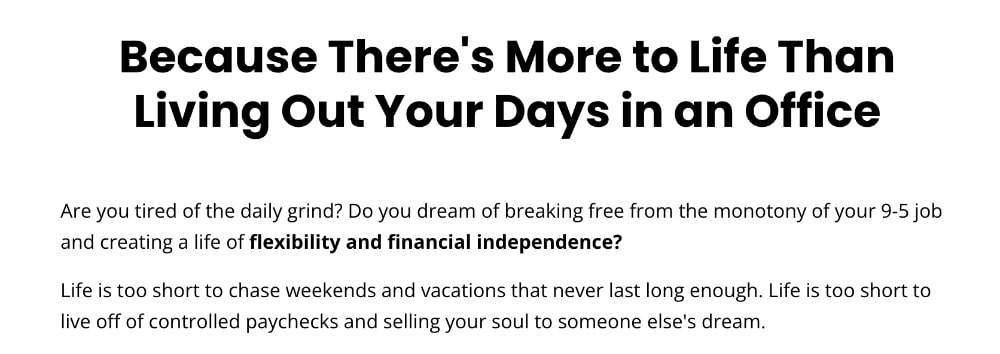Let’s be honest, learning how to write ad copy that sells is a task that is a lot easier said than done, am I right? You know your product or service is amazing, but getting people to notice and take action? That struggle is very real.
Whether you’re pitching your latest ebook, online course, or coaching services, you need ad copy that grabs attention and persuades people to fill in those credit card details.
Other people make it look easy, which leaves you to wonder… How exactly do you craft those magic words that turn casual browsers into paying customers?
Don’t worry, we’ve got your back! We didn’t start out knowing how to write ad copy, but it’s a skill that we leave learned and developed over the years in our own businesses. I’m here to tell you that is is absolutely a skill you can learn with the right strategy in place.
In this guide, I’ll share 10 must-know strategies for creating ad copy that sells like hotcakes. We’re talking tips and tricks to really speak to your audience, push their emotional buttons (in a good way!), and make them feel like your offer is the answer to their prayers.
From nailing that attention-grabbing headline to sprinkling in some FOMO-inducing scarcity, I’ll break it all down in a way that’s easy to understand and implement, whether you’re writing Facebook ad copy, google ad copy, or social media ad copy!
Here’s a summary of the ad copywriting tips and strategies we will cover:
- Understand Your Target Audience: Conduct thorough research to deeply understand your ideal customer’s pain points, desires, and motivations.
- Write Attention-Grabbing Headlines: Craft headlines that pique curiosity and make your audience stop scrolling using power words, questions, and specificity.
- Focus on Benefits, Not Features: Highlight how your product/service improves your customer’s life rather than listing features.
- Highlight Pain Points and Emotional Triggers: Tap into your audience’s deepest frustrations and desires through vivid language and emotional appeals.
- Create a Sense of Urgency and Scarcity: Use language that conveys limited availability or time-sensitivity to encourage immediate action.
- Tell a Compelling Story: Transport your audience into a narrative where they can envision the transformation your offering provides.
- Address Concerns and Overcome Objections: Anticipate doubts and provide evidence, guarantees, and logical counterarguments to build trust.
- Write a Compelling Call-to-Action: Use clear, benefit-driven language that leaves no doubt about the next desired action.
- Use Social Proof and Testimonials: Build credibility through customer reviews, case studies, and influencer endorsements.
- Test, Analyze, and Refine: Continuously optimize through data-driven experimentation to improve performance over time.
Let’s dive into how to write good ad copy that resonates with your audience and most importantly, SELLS!
- 1. Understand Your Target Audience
- 2. Write Attention-Grabbing Headlines
- 3. Focus on Benefits, Not Features
- 4. Highlight Pain Points and Emotional Triggers
- 5. Create a Sense of Urgency and Scarcity
- 6. Tell a Compelling Story
- 7. Address Concerns and Overcome Objections
- 8. Write a Compelling Call-to-Action
- 9. Use Social Proof and Testimonials
- 10. Test, Analyze, and Refine
- FAQs About How to Write Compelling Ad Copy
- Conclusion for Ad Copywriting
1. Understand Your Target Audience
The foundation of successful ad copy in advertising is to understand your target audience.
This step is crucial because if you don’t know who you’re talking to, how can you possibly speak their language and address their specific needs and desires?
Writing generic messages aimed to resonate with everyone is a surefire way to get lost in the advertising noise.
It’s also not enough to just have a general idea of basic demographic information like age and gender, although you can generally find this data easily from Google Analytics.

You need to dig deeper and understand their pain points, goals, fears, and what makes them tick. What are their biggest frustrations or aspirations? How can your product or service provide the solution they’re craving?
This level of relevance and personalization is what captures attention, builds trust, and drives them to click and purchase.
Here are some tips to help you get to know your audience like the back of your hand:
Do Your Research
Start by gathering as much data as you can about your audience. Look at your website analytics, social media insights, and any customer surveys or feedback you’ve collected.

This will give you a good baseline understanding of who your audience is and what they’re interested in.
Create Buyer Personas
Once you have some data, it’s time to create detailed buyer personas. These are fictional representations of your ideal customers, complete with names, ages, occupations, interests, and pain points.
Having these personas will help you visualize who you’re talking to and craft your ad copy accordingly.
Listen and Observe
Don’t just rely on data – get out there and actually listen to and observe your target audience. Join online communities where they hang out, read the comments on their favorite blogs, and pay attention to the language they use and the topics they care about.
Ask Questions
Never underestimate the power of simply asking your audience what they want and need. Send out surveys, conduct interviews, or start conversations on social media. You’ll be amazed at the insights you can gain just by asking the right questions.

The more vividly you can visualize who you’re talking to, the more authentic and compelling your ad copy will become.
2. Write Attention-Grabbing Headlines
Now that you know your audience inside and out, it’s time to reel them in with headlines that demand attention.
Your headline is the first thing people will see, so it needs to be a real showstopper – the kind of line that makes someone stop scrolling and say, “Wait, what’s this about?”

Think about it: with so much content vying for our attention these days, a boring, bland headline is basically the kiss of death for your content.
But a headline that piques curiosity, promises a solution, or just makes someone chuckle? That’s a recipe for more clicks.
Here are some tips for writing headlines that’ll stop your audience in their tracks:
Use Power Words
Certain words just have a way of grabbing people’s attention. Power words like “secret,” “proven,” “surefire,” and “foolproof” are like catnip for curious minds.
Sprinkle in a few of these power words, and your headline will practically leap off the page.
Pique Curiosity
Curiosity is a huge driver for clicks. A headline like “Are You Making This #1 Most Common Mistake in Your Business?” or “My #1 Secret to Success for [Topic]” can be incredibly effective at drawing people in.
Headlines that tease valuable information, like “The Little-Known Trick to [Desired Outcome]” or “What [Influencer] Doesn’t Want You to Know About [Topic],” can also be incredibly compelling.
Use Specificity and Numbers
Our brains are naturally drawn to specifics and numbers. A headline like “7 Surprising Ways to [Desired Outcome]” or “The Exact 3-Step Process for [Pain Point]” promises concrete value and stands out from vague, generic headlines.
Tap into Emotions
Emotions are powerful motivators, so don’t be afraid to tap into them with your headlines. Headlines that evoke curiosity, fear, anger, or even humor can be incredibly effective at grabbing attention and getting people to click.
Remember, your headline is your one-liner, your opening act, your chance to make a killer first impression.
3. Focus on Benefits, Not Features

Okay, so you’ve got your audience’s attention with a killer headline. Now it’s time to really reel them in with compelling ad copy that speaks directly to their desires and pain points.
One trap that many marketers fall into is explaining how great the product is. But they often forget that the WHAT isn’t what people really care about. It’s the WHY.
The features of a product (or service) can be important but what people really want to know is what the product will DO for them. WHY do they need it?
HOW can this product make their life better, easier, or more enjoyable?
Framing your ad copy this way creates a tangible benefit that the consumer is willing to pay for.
For every feature you want to highlight, ask yourself “So what? What’s in it for them?”
Here’s an example. If you’re selling a fitness app, you could list out all the features like calorie tracking, workout plans, and progress monitoring. But these are boring details that they would expect every app to include.
Instead, focus on the the ways that these specific features can improve their life. Maybe it’s finally feeling confident in their own skin, having more energy to keep up with their kids, or achieving the body they’ve always dreamed of.
Those are the kinds of benefits that really resonate and get people saying, “Yes, I want that!”
4. Highlight Pain Points and Emotional Triggers
Think about the last time you made an impulse purchase or invested in something you really wanted. Chances are, it wasn’t just a logical, rational decision – there were emotions involved. Maybe it was the excitement of finally achieving a long-held goal, the fear of missing out on a limited-time offer, or just the sheer desire to treat yourself.
While focusing on benefits taps into rational desires, the most effective ad copy also strikes an emotional chord. After all, the majority of purchase decisions are driven by feelings, emotions, and psychological impulses rather than pure logic.
To really move your audience into a “shut up and take my money” mindset, you need focus on writing ad copy that resonates with your target audience on an emotional level.
The secret is strategically highlighting your audience’s biggest pain points and unconscious emotional triggers. These are the lingering frustrations, unmet cravings, and core human drivers like aspirations, anxieties, and primal urges that act as catalysts for taking action.

Are they driven by desires for status, self-actualization, or love and connection? What unconscious buttons can you push in an ethical, authentic way to flip their mental switch towards action?
Point A vs. Point B Perspective
This is a concept that I call the “Point A Perspective.” It’s writing ad copy that speaks to what your audience is feeling right now – before they have solved their problem.
An example would be talking about the feelings and emotions someone might experience while they are overweight and wanting to change, rather than the benefits they feel after they have reached a solution.
The benefits (Point B) are important to provide credibility but the current feelings (Point A) are what build trust and make your ad copy resonate with them in the moment.
5. Create a Sense of Urgency and Scarcity
You’ve grabbed attention with a killer headline, highlighted unmistakable benefits, and tapped into powerful emotional drivers. Your audience is leaning in, their desire piqued, but they might still be on the fence at this point.
What’s missing is that crucial sense of urgency and scarcity that compels people to stop wavering and take action now before they miss out. A limited window, dwindling supply, or impending cutoff or price increase – these constraints manufacture the fear of loss and kick that “buy now” impulse into high gear.

The Psychology of Urgency
At its core, creating a sense of urgency in your ad copy taps into our deep-seated fear of missing out (FOMO) and loss aversion.
Nobody wants to feel like they’re going to lose out on a great opportunity or deal. As human beings, we’re hardwired to avoid that painful feeling of lack and regret. This can trigger decisive behavior.
But be careful – if you overdo it or use urgency tactics in a manipulative way, you risk coming across as pushy or insincere. The key is to strike the right balance and create a genuine sense of scarcity or time-sensitivity.
Tactics for Creating Urgency
- Limited-Time Offers: Set a clear expiration date for your offer, and remind your audience of the countdown throughout your copy. We offer a limited-time discount in our email sales funnels.
- Limited Quantity: If you only have a certain number of products or spots available, make that scarcity known and watch the FOMO kick in. Many marketers use open and close cart systems to create a sense of scarcity.
- Countdown Timers: There’s nothing quite like a ticking clock to light a fire under people. Use countdown timers on your landing pages or ads to create a sense of urgency.

When used strategically and authentically, creating a sense of urgency in your ad copy can be the final push that turns a “maybe later” into a “yes, I need this now!”
Just make sure your urgency isn’t so fabricated or overblown that it damages credibility. You want to push motivated action, not skepticism. The most effective uses of scarcity are truthful while still cultivating desire and loss aversion.
6. Tell a Compelling Story
To really grip your audience’s imagination and make your offer memorable, you need to weave a captivating narrative into your ad copy that transports them into a world of potent meaning.
Storytelling is one of the most powerful tools in a copywriter’s arsenal because it taps into the intrinsic human love of shared narrative.
Remember that your potential customers are on a journey.
Remember that your potential customers are on a journey, and your ad copy should reflect the different stages of that journey. A well-crafted story will resonate with them on a deep level, making them feel seen, understood, and eager to continue their journey with your product or service as their guide.
The Hero’s Journey
One effective storytelling framework to consider is the “Hero’s Journey.” In this journey, your customer is the hero, and your ad copy should take them through the following stages:
- The Ordinary World: Introduce your audience to the hero’s (their) ordinary world, complete with the challenges, pain points, or dissatisfactions they’re currently facing (Point A Perspective).
- The Call to Adventure: This is about rising to meet the challenge to make the change that they are seeking in their lives. It’s a reminder that staying inside their comfort zone won’t get them where they need to go.
- The Road of Trials: Describe the obstacles and challenges your hero will face on their journey, and how your product will help them overcome these trials.
- The Reward: Paint a vivid picture of the reward or transformation your hero will experience by using your product or service – the improved life, achieved goals, or newfound confidence they’ll gain.
- The Return: Finally, show your audience how their journey will come full circle, with them returning to their ordinary world as a transformed, empowered individual, ready to share their newfound wisdom and success with others.

Of course, you don’t always have the space in your ad copy, especially with social media ads, to write out an entire journey and story. You might have more space for it if you’re including it in a landing page or blog post.
But this is a reminder of the key points to focus on in your ad copy and the type of language you want to use when you speak to your target audience.
It’s a reminder that you can’t do the work for them. Your job is to help them realize that they can do the work and realize their hopes, dreams, and goals.
7. Address Concerns and Overcome Objections
Even with the most compelling ad copy, there’s bound to be some resistance or objections from your audience. Maybe they’re skeptical about your claims, concerned about the cost, or just plain hesitant to take action.
People are honestly looking for reasons NOT to buy, so if they can find one, it’s game over.
The key is to anticipate these objections and address them head-on in your ad copy. Without any roadblocks, you’ll make it a no-brainer for them to say “yes” to your offer.
Anticipate and Acknowledge Concerns
Start by making a list of the most common objections or concerns your target audience might have. You can also ask AI to help you come up with a list of potential objections your customers might face.
If you’re able to, asking your audience directly can be the best way to find out what the most important concerns and points of resistance might be.
These could be related to cost, quality, effectiveness, or any other potential sticking points.
You can’t usually address every single concern or objection in your ad copy, so make sure to focus on what’s most important.
Use language like “You might be thinking…” or “Some people worry that…” to introduce the concern. This shows your audience that you understand their concerns and builds trust and credibility.

Overcome Objections with Evidence and Reassurance
After acknowledging the objection, it’s time to overcome it with evidence, data, and social proof. Share customer testimonials, case studies, or third-party endorsements that directly address the concern and demonstrate the value of your offering.
For objections related to risk or uncertainty, consider offering a money-back guarantee or risk-reversal policy. This can help alleviate fears and make your audience feel more comfortable taking a chance on your product or service.
Sometimes, the best way to overcome an objection is to reframe it in a more positive light. For example, if the objection is related to cost, you could reframe it as an investment in their future success or a small price to pay for the incredible value they’ll receive.
This level of transparency and trust-building can be the difference between a lukewarm response and a flood of conversions.
8. Write a Compelling Call-to-Action
Your call-to-action (CTA) is the final push that motivates your audience to take the next step after reading your persuasive ad copy. It’s the culmination of all your hard work, so you’ll want to make sure it packs a punch and leaves no doubt in your audience’s mind about what they need to do next.
Use action-oriented language with verbs like “get,” “buy,” “subscribe,” or “claim” to make it crystal clear what action you want them to take. Incorporate language that creates a sense of urgency or scarcity, such as “limited-time offer” or “only X spots left.” This can be a powerful motivator to act now.
Even in your CTA, reinforce the key benefits your audience will experience by taking action. For example, “Get Instant Access to Our Proven Weight Loss System” or “Claim Your Free Consultation and Start Saving Today.” Highlighting the benefits keeps them front and center.
Make your CTA visually striking so it stands out from the rest of your copy. Use contrasting colors, larger font sizes, or eye-catching graphics to make it impossible to miss.
Your CTA is the final hurdle between your audience and the desired outcome you’ve been building toward with your ad copy.
9. Use Social Proof and Testimonials
When it comes to building trust and credibility with your audience, few things are as powerful as social proof and testimonials. In a world of constant marketing messages, seeing real people vouch for a product or service can be the deciding factor that tips the scales in your favor.

There is a reason that recent Google algorithm updates have started favoring Reddit threads: People want to hear honest reviews from real people.
Psychologically, social proof works because people tend to follow the lead of others, especially those they perceive as similar to themselves. By including positive reviews, case studies, or endorsements from satisfied customers or industry influencers, you’re making your offer more appealing by leveraging this principle.
Here are a few tips for your social proof and testimonials:
- Look for customers who are relatable to your target audience in terms of demographics, interests, or pain points. The more your audience can see themselves in the customer, the more they’ll think, “If it worked for them, it can work for me too.”
- Use testimonials with specific details about results or benefits, including numbers, statistics, and concrete examples for maximum credibility.
- Adding visuals like photos or video testimonials makes your social proof even more powerful by putting a real face and voice behind the words.
- Diversify your testimonials throughout your ad copy to reinforce claims and build trust continuously.
- Prominently display logos, awards, certifications, or accreditations you’ve earned as well for instant credibility boosts.
By strategically incorporating social proof elements like testimonials and endorsements into your ad copy, you tap into that powerful psychological principle of social validation.
Your audience sees others have succeeded with your offer, making them more likely to trust your claims and take action.
10. Test, Analyze, and Refine
Even after implementing all the strategies and best practices for writing compelling ad copy, your work isn’t done. The most successful marketers and copywriters know that testing, analyzing, and refining their copy is crucial for optimizing performance and maximizing conversions.
Don’t just set your ad copy live and hope for the best. Instead, approach it with a data-driven mindset and a willingness to experiment.
Gather and Analyze Data
- Run A/B tests to compare different headlines, body copy, CTAs, and even design elements to see what resonates best with your audience.
- Look at metrics like click-through rates, conversion rates, and engagement to determine which variations are outperforming others.
- Survey your audience, read through comments and reviews, and pay attention to the language and sentiments expressed.
This can provide valuable insights into what’s working, what’s not, and how you can improve your copy to better connect with your target market.
Refine and Optimize
Tweak your copy based on your findings, continuously testing and iterating to see what moves the needle. Don’t be afraid to make bold changes or try out entirely new approaches – sometimes a fresh perspective is exactly what’s needed to break through.
Remember, writing effective ad copy is an ongoing process, not a one-and-done task.
The most successful marketers are never satisfied with “good enough” – they’re always striving to create ad copy that’s more persuasive, more engaging, and more effective at driving conversions.
FAQs About How to Write Compelling Ad Copy
Conclusion for Ad Copywriting
Writing ad copy that truly sells is both an art and a science. It requires a deep understanding of your target audience, a mastery of persuasive language and emotional triggers, and a commitment to continuous testing and optimization.
Throughout this comprehensive guide, we’ve explored 10 proven strategies for ad copywriting that captures attention, builds desire, and ultimately drives conversions. From understanding your audience’s pain points and desires to leveraging the power of storytelling and social proof, each strategy has a place in your ad text.
As you implement these strategies and techniques, remember to approach your ad copy with a spirit of curiosity and a willingness to adapt. Pay attention to the metrics, gather qualitative feedback, and don’t be afraid to make bold changes or try entirely new approaches.
Writing ad copy that truly sells is a journey, one that requires patience, persistence, and a commitment to continuous improvement. But the rewards are so worth it!